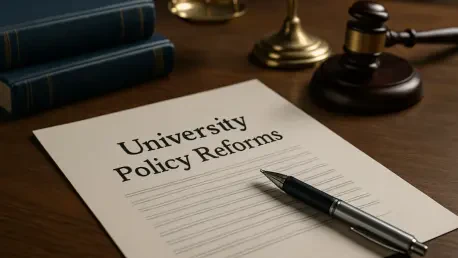In a striking display of ideological friction, a heated dispute has erupted between President Donald Trump and California Governor Gavin Newsom over a bold federal initiative aimed at reshaping university policies across the nation. This conflict centers on a proposed plan that would tie enhanced federal funding to the adoption of conservative measures at select higher education institutions, a move that has sparked intense debate about the balance of power between state and federal authority. With California’s progressive values at odds with the federal agenda, this clash highlights a deepening divide in the realm of academia, where financial incentives are being wielded as tools of influence. The implications of this standoff extend far beyond funding, touching on the core principles that define American higher education and the autonomy of its institutions.
Federal Initiative Sparks Controversy
The Compact for Academic Excellence Unveiled
At the heart of this controversy lies the Compact for Academic Excellence in Higher Education, a federal proposal championed by President Trump that targets nine prominent public and private universities, including the University of Southern California (USC), Vanderbilt, Brown, and Dartmouth. This initiative offers substantial federal funding in exchange for implementing specific conservative policies, such as enforcing gender-specific rules for bathrooms and women’s sports, eliminating race and gender considerations in admissions, mandating standardized test scores for applicants, capping international student enrollment at 15%, and reforming groups deemed anti-conservative. While the University of California, Berkeley (UC Berkeley) is not currently included, speculation abounds that additional schools could be added, intensifying concerns about the scope of this federal push and its potential to reshape campus cultures nationwide.
Financial Incentives as a Policy Lever
The use of financial incentives to drive policy changes in higher education is not a new tactic, but the scale and specificity of this Compact have raised eyebrows among educators and policymakers alike. By offering enhanced federal funding as a reward, the initiative places universities in a challenging position, particularly those reliant on government support to sustain operations and research programs. For institutions like USC, the promise of additional resources is tempting, yet it comes at the cost of aligning with policies that may clash with their established values or state-level mandates. This approach underscores a broader strategy of leveraging economic power to influence academic environments, a move that critics argue threatens the independence of higher education and prioritizes ideological conformity over intellectual freedom.
State Resistance and Broader Implications
California’s Defiant Stance Against Federal Pressure
Governor Newsom has emerged as a staunch opponent of the federal Compact, vowing to protect California’s progressive ideals by threatening to withhold billions in state funding, including Cal Grants, from any university in the state that complies with the federal terms. In a pointed social media statement, Newsom branded the initiative as radical, arguing that it undermines the rights of students, faculty, and researchers while eroding academic freedom. This bold countermeasure reflects California’s deep-rooted commitment to diversity and inclusion in education, positioning the state as a bulwark against what many see as federal overreach. The governor’s stance has resonated with many in the academic community, who view his resistance as a necessary defense against policies that could fundamentally alter the ethos of their institutions.
The Tug-of-War Over University Autonomy
Caught in the crossfire of this political battle, California universities like USC face an unenviable dilemma as they navigate competing financial dependencies. Political scientist Melissa Michelson from Menlo College notes that while presidents have historically used funding to sway policy, Newsom’s parallel use of state-level financial leverage is less common and adds a layer of complexity to the situation. Institutions risk losing critical state support if they align with the federal Compact, yet rejecting federal funds could strain budgets and limit opportunities for growth. This tug-of-war exemplifies a larger struggle over who ultimately controls the direction of higher education, raising questions about whether universities can maintain their autonomy amid such intense external pressures from both state and federal actors.
Student Voices and Ideological Divides
Among students, particularly at UC Berkeley, there is palpable unease about the potential ramifications of the federal initiative, even though their campus is not yet directly targeted. Many have expressed frustration, with some describing the proposed policies as a direct affront to the inclusive values they hold dear, while others have voiced strong support for Newsom’s pushback as a reflection of California’s identity. The sentiment on campus reveals a broader cultural and ideological divide, with higher education becoming a battleground for competing visions of society. Although UC Berkeley has remained officially silent on the matter, the student body’s reactions suggest a groundswell of concern that could influence future discourse if more schools are drawn into the Compact, amplifying the stakes of this ongoing conflict.
Looking Ahead to Resolve the Standoff
Reflecting on this pivotal moment, the clash between President Trump and Governor Newsom captures a profound struggle over the soul of American higher education. The tension between federal mandates and state resistance underscores deep ideological rifts that challenge the very foundation of academic independence. Newsom’s unwavering opposition, bolstered by student sentiment in California, stands in stark contrast to the federal push for conservative reforms, creating a deadlock with no easy resolution in sight. As the debate unfolds, it becomes evident that the strategic use of funding as leverage has redefined the relationship between government and universities. Moving forward, a potential path to de-escalation could involve dialogue between state and federal leaders to establish clear boundaries for influence in education, while universities might seek alternative funding sources to preserve their autonomy. Ultimately, the resolution of this conflict will likely shape policy precedents for years to come, demanding careful consideration of how to balance financial needs with the principles that define higher learning.








